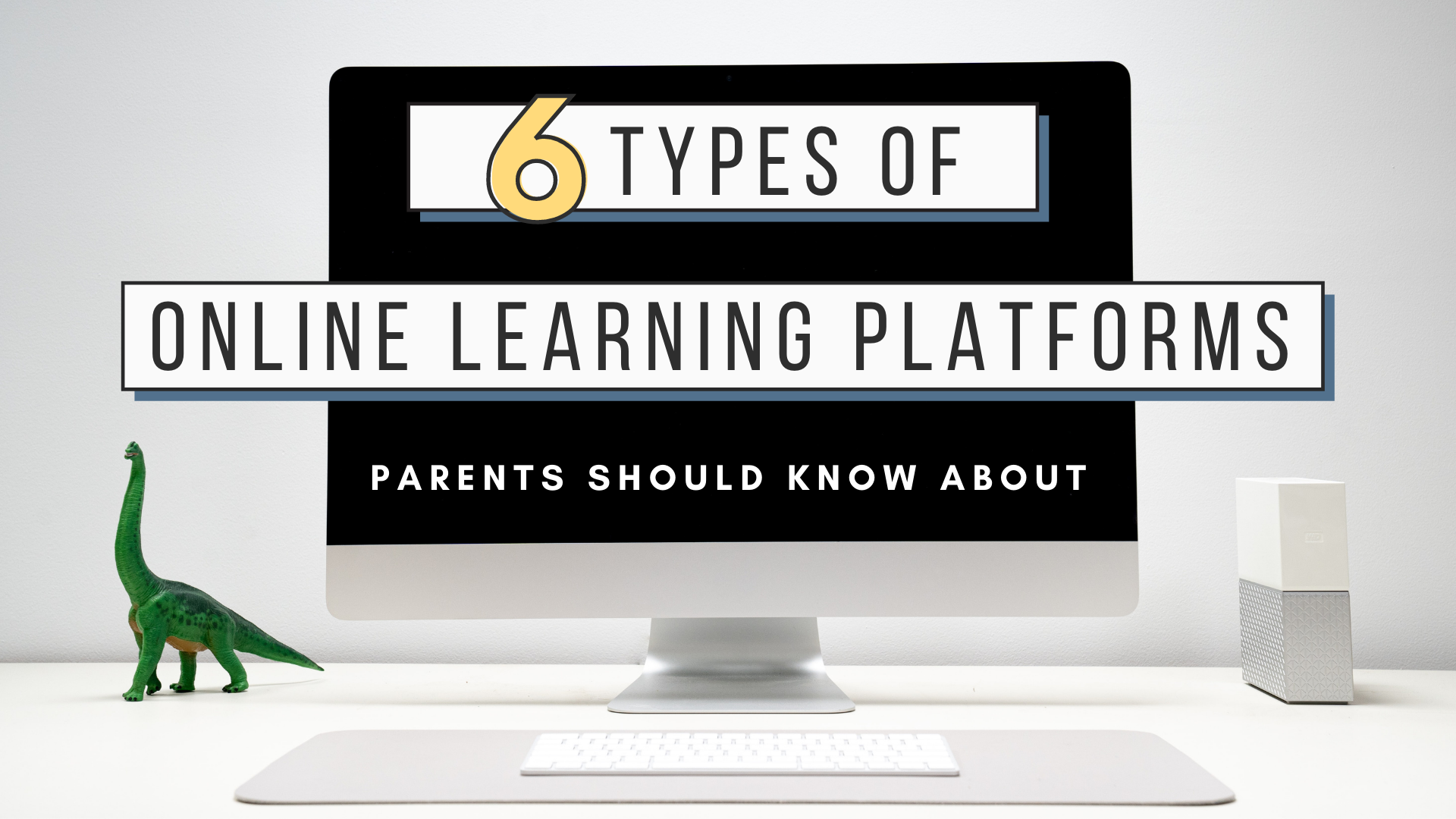6 Types of Online Learning Platforms Parents Should Know About

With schools all over Singapore making the shift to home-based learning (HBL) and the suspension of physical tuition classes during the Circuit Breaker period earlier this year, it is suffice to say that we are no strangers to online learning by now. However, are you aware of the various forms that online learning can take place in? In this blog post, we will be sharing about the 6 types of online learning platforms as well as the features and effectiveness of these platforms.
Synchronous vs Asynchronous Learning
“If a child can’t learn the way we teach, maybe we should teach the way they learn.” – Ignacio Estrada
To start off, we should know that students are unique individuals with different learning styles. Learning can be broadly categorised into two approaches.
Synchronous approach
Synchronous learning takes place when both the teacher and the student are online at the same time and actively interacting with each other in real time. The most obvious form of synchronous learning will be online classes conducted through live-streaming video calls. This is a highly engaging form of learning that allows a student to get instant feedback from the teacher.
Asynchronous approach
Asynchronous learning takes place when the teacher and the student are not online at the same time. For instance, lesson materials are uploaded onto a platform by the teacher for the student to access later. This approach to learning provides flexibility and the student is able to adjust the pace of learning in terms of his or her needs.
Some students perform better with synchronous learning while others thrive under asynchronous learning. If you are thinking of getting your child started on online learning, here are the different types of online learning platforms that you can consider. This way, you can choose the most suitable platform for your child and optimise learning based on his or her preferred approach.
1. Learning Management Systems

As a parent, have you encountered any Learning Management System (LMS)?
Yes, the Student Learning Space (SLS) would easily come to mind!
An LMS works like a virtual classroom, enabling teachers to stay connected with their students online. It offers a platform for teachers to upload lesson materials, assign homework or even create assessments and quizzes for their students. They can also make announcements and track their students’ learning progress. Likewise, students can complete and submit their assignments through the LMS platform. The LMS can also involve elements of synchronous learning as teachers schedule live classes via online conference calls with their students.
Just like what is is called, the LMS is more like a management tool that supports and complements learning. Taking the SLS for instance—teachers can create or curate customised learning packages and have them uploaded for their students. However, it is not meant to replace classroom teaching and face-to-face interaction. Nevertheless, the LMS is certainly a good way to introduce and incorporate the use of technology to enhance the learning experience of students, especially so during crucial periods when physical classes are not viable.
2. MOOCs

MOOCs refer to massive open online courses, which are contained within an online content marketplace. Some course are entirely free, while others require a one-time payment in order to access the entire course. Prominent MOOCs providers include platforms like Udemy and Cousera, where there are thousands of online courses to pick from. However, such platforms are typically catered for older students or adult learners as it involves independent learning with minimal guidance. This makes it not quite suitable for primary and secondary-level students who still require some discipline and adult supervision.
Although the courses are prepared by teachers or tutors with the relevant expertise, there is no guarantee on the quality of teaching as well as the course materials. You would most likely need to refer to reviews by existing students in order to make informed choices when selecting courses. There is no limit to enrollment and students are usually from diverse backgrounds. With these open-source learning platforms, distance learning is made possible and education is now affordable and available to students all over the globe.
3. Live Online Classes

Since the start of HBL, many tuition centres have ventured into providing live online classes alongside physical classes. Live online classes take place in a virtual classroom, making them a form of synchronous learning. Both the teacher and students have to be online and logged into the platform at the same time. Lessons are live-streamed and students can interact with their teacher through voice, video and text. Platforms offering these live classes usually have a “whiteboard” feature that allows collaborative work and the sharing of lesson materials such as quizzes and presentation slides. Since there is live interaction between students and their teacher, students are more likely to stay engaged throughout the lesson and they can also receive immediate and real-time feedback of their work and clarification of existing doubts. With these platforms, besides providing some semblance of the face-to-face interaction found in classrooms, students can now attend their classes from the comforts of home without spending additional travelling time going to schools and tuition centres.
Similar to physical classes, live online classes are scheduled with fixed dates and timings. This offers no flexibility in timing, which is something you should take into consideration if your child has other activities or classes lined up in his or her schedule. Another thing to take note of is that technical issues may arise sometimes and this may cut into the lesson duration. If there is a high teacher-student ratio, there is also the possibility that the teacher is unable to fully cater for every individual student and your child may miss out on having his or her doubts fully clarified.
4. Homework Assistance Platforms

You may have come across online forums or discussion boards where parents or students would post difficult homework questions and attempt to seek answers from some kind strangers online, but do you know that there are platforms that actually provide such a service? Through such platforms (or apps), a student can simply type out or capture an image of his or her homework question, wait for a mentor to pick up the session and then receive one-to-one assistance from the mentor. This is usually done through a live chat interface and the mentors are paid based on the number of questions they have answered. These platforms offer a personalised form of learning as the student is able to directly clear existing doubts that are relevant to him or her. Learning also becomes flexible as students can submit their questions anytime of the day and receive instant feedback from a pool of online mentors.
Before signing up for an account on one of these platforms, it is good to check that the mentor selection process for that particular platform is stringent. Mentors should display high levels of proficiency in the subjects they are teaching (i.e. evidence of good academic results or passing a proficiency test). They should also be familiar with the content of local MOE syllabuses because the last thing you want is paying money for your child to be misguided with wrong information by mentors of dubious backgrounds.
5. Online Video Lessons

In contrast with live online classes, online video lessons are prerecorded and uploaded onto the platform. These lessons are more structured in a way as they most likely would have gone through post-processing with their content vetted through before they were uploaded to be viewed by students. With prerecorded lessons, students can enjoy even greater flexibility as they can learn anytime and anywhere. Compared to scheduled classes (physical or online), there is no need for students to sit and go through the entire duration of the lesson. Instead, they can simply fast-forward or skip through concepts they already have a clear knowledge of and focus on their weaker topics. Just like catching your favourite drama series through an online streaming service, you would much rather have all the episodes uploaded for you to binge on instead of having to wait another week or so for the next episode.
On the flip side, going through prerecorded lessons can be quite a passive (aysnchronous) form of learning for students. They are unable to interact with the teacher on the screen and have no way of clarifying their doubts immediately during the lesson itself. However, it is common nowadays to see such platforms integrating interactive elements to their prerecorded lessons. For instance, there may be pop-up quizzes appearing throughout the video that act as checkpoints to ensure that the student has fully understood the contents of the lesson.
6. Online Assessments

Practice makes perfect, so what better way is there to help your child in his or her learning than getting some assessment books to work on? This time, however, the assessment practices can be easily accessed online! With these online assessment platforms, students can reinforce learning and test their understanding with questions of different topics and difficulty levels. Questions are typically curated from past-year exam papers of various schools, which are great in helping your child get exposed and used to questions they may face in upcoming exams. Besides being the more environmentally-friendly alternative to assessment books, doing assessments online also helps to save time as scores are tabulated instantly upon submission and answers with full solutions can be accessed immediately.
More advanced platforms pride themselves as having incorporated A.I technology into their assessments, which can spot a student’s weaker topics and generate more personalised questions to address any learning gaps. However, a limitation of such platforms is that there is not much teaching elements besides providing the solutions to their questions. Students would have to learn independently, so a certain level of discipline is required.
And there you go – the 6 types of online learning platforms you may encounter. With so many options available online, the main consideration is the suitability of the platform to your child’s educational needs. When choosing a suitable online learning platform for your child, a useful tip is to take advantage of the free trials offered by many of these platforms. This way, you can get to experience the features offered first-hand and make a more informed decision.


